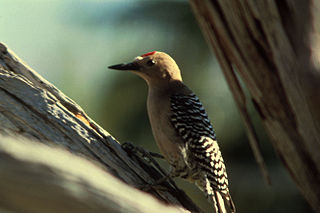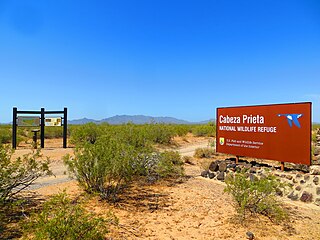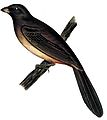
The phainopepla or northern phainopepla is the most northerly representative of the mainly tropical Central American family Ptiliogonatidae, the silky flycatchers. Its name is from the Greek phain pepla meaning "shining robe" in reference to the male's plumage.

The Gila woodpecker is a medium-sized woodpecker of the desert regions of the southwestern United States and western Mexico. In the U.S., they range through southeastern California, southern Nevada, Arizona, and New Mexico.

Abert's towhee is a bird of the family Passerellidae, native to a small range in southwestern North America, generally the lower Colorado River and Gila River watersheds, nearly endemic to Arizona, but also present in small parts of California, Nevada, Utah, New Mexico, and Sonora in Mexico. The name of this bird commemorates the American ornithologist James William Abert (1820–1897).

Cabeza Prieta National Wildlife Refuge (CPNWR) is located in southwestern Arizona in the United States, along 56 miles (90 km) of the Mexico–United States border. It is bordered to the north and to the west by the Barry M. Goldwater Air Force Range, to the south by Mexico's El Pinacate y Gran Desierto de Altar Biosphere Reserve, to the northeast by the town of Ajo, and to the southeast by Organ Pipe Cactus National Monument.

The following is an alphabetical list of articles related to the U.S. state of Arizona.

Aridoamerica denotes an ecological region spanning Northern Mexico and the Southwestern United States, defined by the presence of the culturally significant staple foodstuff Phaseolus acutifolius, a drought-resistant bean. Its dry, arid climate and geography stand in contrast to the verdant Mesoamerica of present-day central Mexico into Central America to the south and east, and the higher, milder "island" of Oasisamerica to the north. Aridoamerica overlaps with both.

A saguaro boot is the hard shell of callus tissue, heavily impregnated with lignin, that a saguaro cactus creates to protect the wound created by a bird's nesting house. The bird pecks through the cactus skin, then excavates downward to hollow out a space for its nest. When the saguaro dies, its soft flesh rots, but its woody infrastructure lasts much longer. So does the hollowed-out callus whose roughly boot-like shape gives it the name of "saguaro boot."

The Hassayampa River Preserve is a 770-acre riparian nature reserve owned by The Nature Conservancy in the US state of Arizona, near Wickenburg in Maricopa County. The Hassayampa River has mostly subterranean flows for most of its 113 miles (182 km) length, the stretch contained within the preserve has year-round flowing water.












